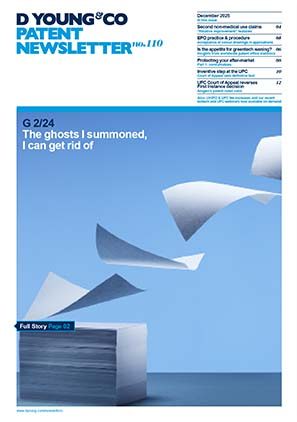Can artificial intelligence be patented in Europe? Lessons from T 0702/20
The number of patent applications for artificial intelligence (AI) inventions is increasing year on year across a wide range of technology areas. In this article, we review European patentability requirements for AI inventions with a focus on lessons from T 0702/20.
Requirements for patentability
In order to be patentable, the European Patent Convention (EPC) requires inventions to:
- Be new.
- Involve an inventive step.
- Be susceptible of industrial application.
In addition to these requirements, the EPC specifically excludes some categories of subject matter from patentability. These include mathematical methods and computer programs which are both relevant to AI. However, these categories of subject matter are only excluded from patentability to the extent that they are claimed “as such” (Article 52 EPC).
It is easy to avoid claiming this kind of subject matter “as such”. In established case law, excluded subject matter is not claimed “as such” if it has technical character by virtue of including “any hardware”. As a result, a mathematical method implemented on a computer is not a mathematical method “as such”, and is therefore not excluded from patentability.
This effectively transfers the battleground to inventive step which requires the invention to provide a non-obvious solution to a technical problem.
An area of contention for many AI inventions is therefore the question of whether the problem they are solving is a technical problem.
A neural network with loose couplings
In T 0702/20, the invention related to “a hierarchical neural network apparatus implemented on a computer”. Since the claimed apparatus was implemented in hardware, it was not claimed “as such” and was not excluded from patentability.
The application discussed conventional techniques that reduce computational requirements for hierarchical neural networks “by forming loose couplings between nodes” (EP308908A1, [0004]). It noted that these “require pre-learning to form loose couplings before carrying out classifier learning… which requires a lot of time and computation” (EP308908A1, [0008]).
The application indicated that “it is an object of the present invention to provide a hierarchical network apparatus…capable of speeding up the classifier learning and discriminating processing by forming loose couplings independently of the learning data” (EP308908A1, [0009]).
This was achieved by the neural network “being formed by loose couplings between the nodes in accordance with a sparse parity-check matrix of an error correcting code” (EP308908A1, claim 1).
At first instance, the claimed invention was found by the Examining Division to be novel but to lack an inventive step. While the Examining Division agreed that the use of the sparse parity-check matrix of an error correcting code was novel, the Examining Division did not agree that this solved a technical problem.
The appellant’s arguments as to why the neural network was patentable
The appellant argued that:
- In contrast with conventional techniques, the claimed invention “allowed for a more efficient implementation by reducing the computing and storage requirements, so that networks could be placed on smaller devices.” (T 0702/20, 6.2).
- “An artificial neural network was a mathematical algorithm meant to mimic the human brain…It allowed the automation of complex tasks, so that the computer could perform them instead of a human…A neural network was thus not an abstract mathematical method, but it used mathematics to solve a technical problem, as was the case in cryptography.” (T 0702/20, 6).
- “A neural network was not a conventional computer program in that its functioning was not determined by the programmer but by the data used for the training. The programmer could not predict how the neural network would work. If its execution was stopped, the programmer would not understand the significance of the values of its mathematical parameters…[A neural network implemented on a computer sets the computer up to] function like an artificial brain.” (T 0702/20, 6.1).
The Board of Appeal’s replies
The Board of Appeal was not convinced by these arguments.
In relation to the reduced computing and storage requirements, the Board of Appeal noted that these were a result of a loosely connected network that learned differently to a fully connected network and therefore did not perform the same task. The reduction in computing and storage requirements was therefore a result of causing the computer to perform a less burdensome task, not of causing the computer to function differently. This was therefore “insufficient to establish a technical effect.” (T 0702/20, 14.1).
The Board of Appeal did not agree that artificial neural networks function like a human brain. In particular, the Board of Appeal noted that an artificial neural network’s “parameters and provided results are fully determined, given the training data and the training procedure: at its core, as explained above, a neural network is a mathematical approximation function, which can be simple and understandable if the network is small… It is only the sheer complexity of a larger neural network that makes it appear unpredictable. That a learning system is complex is not sufficient to conclude that it replicates the functioning of a brain.” (T 0702/20, 16.1).
Finally, the Board of Appeal drew a contrast with cryptography. The Board of Appeal noted that while cryptography inventions are also independent of the data being encrypted (in the same way that the claimed neural network is independent of the data being learnt), cryptography inventions are different because they produce the technical effect of improving the system security of the encrypted messages. (T 0702/20, 18).
The Board of Appeal concluded that following the “any hardware” approach, the claimed subject matter was not excluded but that since it did not produce a technical effect it did not involve an inventive step. The appeal was therefore dismissed.
Ways in which AI can be patentable in Europe
There are still plenty of patentability opportunities for AI inventions in Europe.
New, non-obvious AI inventions can be patented in Europe provided that they have a technical effect that solves a technical problem across their full scope.
Indeed, it its final remarks the Board of Appeal stressed that “there can be no reasonable doubt that neural networks can provide technical tools useful for automating human tasks or solving technical problems. In most cases, however, this requires them to be sufficiently specified, in particular as regards the training data and the technical task addressed.” (T 0702/20, 20).
This is in line with other case law and is reflected in the European Patent Office’s Guidelines for Examination. In particular, the Guidelines for Examination provide these examples in G II 3.3.1:
- “The use of a neural network in a heart monitoring apparatus for the purpose of identifying irregular heartbeats makes a technical contribution.
- The classification of digital images, videos, audio or speech signals based on low-level features (e.g. edges or pixel attributes for images) are further typical technical applications of classification algorithms.”
Conclusion
Although advances in the field of AI itself are generally not patentable in Europe, there are plenty of opportunities to patent AI inventions if they are sufficiently specified for solving a technical problem. If you have any questions or concerns regarding this area your D Young & Co representative is here to help.

